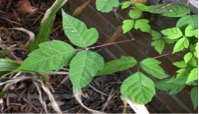Identifying and Dealing With Poison Ivy
Poison Ivy is found in every state east of Colorado, with some populations in extreme southern Arizona and New Mexico. The plant can grow in almost any soil except arid desert, but is especially fond of edge habitats where forest meets open space. New suburban areas are providing increased habitat opportunities, and increased carbon dioxide levels which have caused both the strength and growth of poison ivy to double over the past fifty years. Poison ivy leaves have distinctive features, the most notable is the three leaflets growing on short stems alternating along the main vine. The leaves are pointed and mostly smooth, aside from one or two notches generally found on the outside of the right and left leaflet, giving some leaves the semblance of sharp mittens. Height and size are not reliable ways to identify poison ivy because the plant can grow as a trailing vine along the ground about ankle high, as a climbing vine with reddish hairs, that grow into the tops of trees, sending slender branches straight out three to four feet away from the trunk near the top of the tree and with leaflets spreading along the main vine up the trunk, or even as a free-standing shrub that commonly grows five feet high and with a similar spread. Both the climbing vine and shrub tend to have larger, broader leaves with less definition than the trailing vine, but they still maintain the alternating pattern of three leaflets. Poison ivy leaves are bright green in summer, with large leaves often becoming shiny and slightly darker than the small leaves. In the fall, the leaves become brilliant yellow or red. Urushiol is the active oil in poison ivy that causes itchy rashes or blisters after contact. This oil is found in every part of the plant, and remains potent in dead plants or on surfaces that do not absorb the oil such as pet fur or work gloves, so use caution when handling them. If one does contact poison ivy, do not wash with warm or hot water, as this will open pores and exacerbate the reaction. Immediate use of cold water and soap or rubbing alcohol may remove the oil and prevent a reaction, but always be cautious about spreading residual oil to sensitive areas, particularly the eyes and face. The hands are generally the last to show signs of contact, so if spending time in an area with poison ivy, be wary of what you touch.
